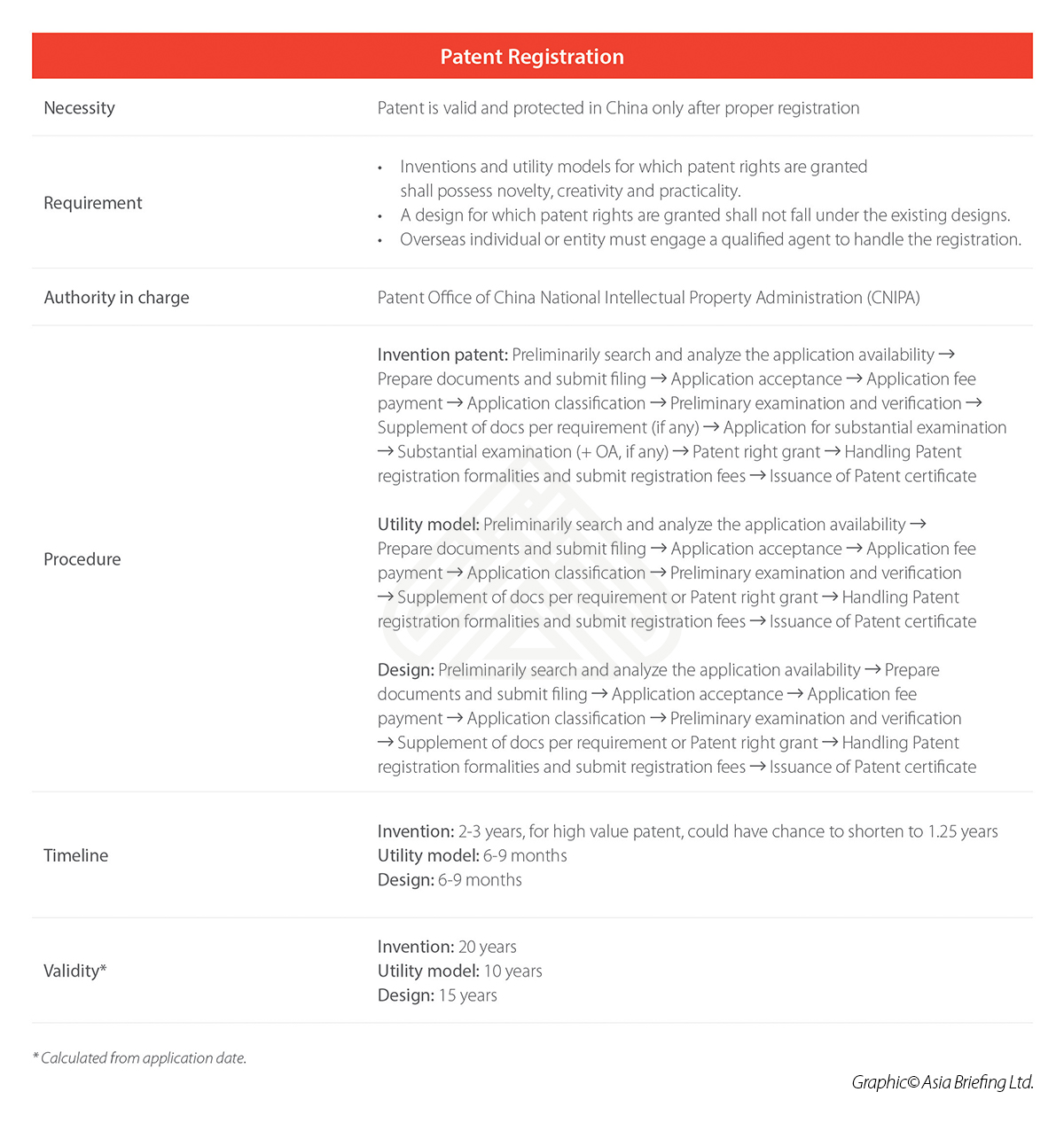Tips and Considerations for Patent Application in China
Intellectual property protection is crucial before entering the China market and investors with valuable patent technologies are advised to speedily apply for patents for protection and to avoid infringements. In this article, Monica Li, Business Advisory Manager with Dezan Shira & Associates, discuss important aspects of China’s patent system, including the types of patents allowed, scope of protection, and procedures for registration and post-registration maintenance.
With the removal of COVID-19 restrictions, China is once again ready to welcome new foreign entrepreneurs to invest in the China market. However, prudent consideration of factors such as intellectual property protection is essential prior to market entry. Many investors looking to invest in China may own unique patent technologies of great value, which need to be protected by obtaining patents in China.
To help entrepreneurs and foreign investors protect their patents in the country, we explain how China’s patent system works and share some tips for navigating the registration procedures, including considerations for pre- and post-registration procedures.
Understanding China’s patent system
It is important to understand how China’s patent system works, including the different patent types, the process for obtaining a patent, and the scope of protection offered by a patent.
What are the patent types allowed in China?
China’s patent law provides for three types of patents:
- Invention patents, granted for new and useful technical solutions;
- Utility model patents, granted for incremental improvements to existing products or processes; and
- Design patents, granted for new and original designs of articles.
What is the scope of protection offered by a patent in China?
A patent in China offers the patent holder the exclusive right to prevent others from making, using, selling, or importing the patented invention in China without their permission. The scope of protection offered by a patent in China is determined by the claims of the patent, which define the boundaries of the invention.
In general, the scope of protection for an invention patent is broader than that for a utility model patent. An invention patent enjoys protection for up to 20 years from the date of filing, while a utility model patent offers protection for up to 10 years from the date of filing. Design patents provide the patent holder with protection for up to 15 years from the date of filing.
It is important to note that the scope of protection offered by a patent in China is limited to the jurisdiction of China. Therefore, it is important to obtain patents in other countries if you want to protect your invention globally. Additionally, patent protection does not guarantee commercial success, as there may be other factors that impact the commercial viability of an invention.
Process for obtaining a patent
The procedures for obtaining a patent differ slightly depending on the type of patent that is being applied for, although the main procedures remain the same for all applications.
Preliminary research
Applying for all types of patents in China starts with preliminary research to assess the application availability of the desired patent.
Normally, the third-party patent agencies shall help to find out whether a similar patent has been registered in China at this stage. For invention patent, the scope of preliminary research should be expanded to other countries as well. This is because for an invention patent, in the substantive examination period, a cross-country patent search would be required anyway. Based on the research result, the patent agencies will give analysis on whether it’s worth trying to apply for the patent in China.
In practice, there are cases where the applicant has already owned a patent in other countries outside China and already sold relevant patent products to China. It could lead to the loss of novelty, which is one of the most fundamental conditions for granting a patent. In this scenario, the selling of the patent products to China might lead to the failure of patent registration in China. Therefore, foreign investors are advised to make patent registration before entering the China market.
Prepare documents and submit the filing
The next step is to prepare the requisite documents and submit the application to the China National Intellectual Property Administration (CNIPA). These documents generally include:
- Patent Request Letter
- Claims defining the scope of the invention
- Patent Description
- Abstract of Description
- Drawings to Description
- Qualification Certificate of applicant (Incorporation Certificate or Passport Copy)
- Others (e.g., Substantive Examination Request for Invention Patent)
These documents must be submitted in Chinese or translated into Chinese if they are in another languages.
In the registration application process, supplementary documents or explanations would be required by the CNIPA where necessary. The applicant must keep an eye on the progress and reply to the said authority within the given timeframe. Otherwise, the application shall be deemed as withdrawn.
Application classification
After the CNIPA has accepted the application (which the applicant will be notified via a Notification Letter right after the submission of the documents as listed above), the applicant must pay application fee within two months after receiving the Notification Letter. After the fee has been paid, the patent office of the CNIPA will classify the type of patent and make sure it goes into the corresponding process of examination.
Examination and verification
At this stage, the CNIPA will begin preliminary examination and verification (i.e., to verify the whether all documents are qualified, whether the patent is registerable, etc.), during which it may request supplementary documentation from the applicant.
As mentioned earlier, the application procedure is different for different types of patents. If applying for an invention patent, the applicant must apply for a substantial examination to the CNIPA, which is to ask for the patent authority’s examination on whether the invention patent has novelty and see whether the invention patent is registerable in China . After the CNIPA has conducted the substantial examination, the applicant will be granted the patent rights if no reason for rejection is found.
If applying for a utility model or design patent, the substantial examination is not required, and the CNIPA will grant the patent rights after all the required supplementary documentation has been submitted and the availability of the patents registration has been verified.
Patent registration formalities and issuance of patent certificate
After the patent right has been granted by the CNIPA, the applicant must handle the patent registration formalities, which mainly refer to payment of the required patent fee. The CNIPA will issue the patent certificate afterwards.
Timeline of patent registration
Note that due to the additional requirements to undergo a substantial examination, applying for an invention patent may take two to three years, presuming that the patent application is accepted by the CNIPA, and no unexpected issues arise during the application process. However, if the patent is assessed as a high-value patent, the timeline might be shortened to around 1.25 years.
High-value patents refer to:
- Invention patents for strategic emerging industries
- Invention patents that have a patent right of the same family overseas
- Invention patents with a life of more than 10 years
- Invention patents with higher pledged financing amount
- Invention patents won the State Science and Technology Award or the China Patent Award
Strategic emerging industries mainly include the new generation of information technology industry, high-end equipment manufacturing industry, new material industry, biological industry, new energy automobile industry, new energy industry, energy conservation and environmental protection industry, digital creative industry, related service industry, etc.
Meanwhile, applying for a utility model patent or design patent generally takes around 6-9 months presuming that the patent application is accepted by the CNIPA and no unexpected issues arise during the application process.
Post-registration maintenance
Patent owners should be aware that obtaining a patent is not the end of all patent procedures in China. After registering a patent in China, there are several important considerations that you should keep in mind to protect your patent rights and maximize the value of your invention. These include:
- Maintenance: Once a patent has been granted in China, it is important to keep up with maintenance fees and annuity payments to ensure that the patent remains in force. Failure to pay these fees can result in the patent becoming invalid.
- Enforcement: If you believe that someone is infringing on your patent rights in China, it is important to take action to enforce your rights. This may include sending a cease-and-desist letter, initiating legal proceedings, or negotiating a licensing agreement.
- Licensing: If you are not using your patented invention in China, you may consider licensing your patent to others for a fee. This can provide a source of revenue and help you to maximize the value of your invention.
- Monitoring: It is important to monitor the market in China to ensure that no one is infringing on your patent rights. This can involve conducting regular searches of patent databases and monitoring the activities of competitors.
- Recording: Record your patent with China Customs to prevent infringement and protect your rights. Customs recording allows China Customs to intercept goods that are suspected of infringing someone’s patent rights and to take appropriate action.
Tips for successful patent registration in China
Work with a professional patent agent
According to Article 18 A of the Chinese Patent Law, a foreigner, foreign enterprise, or any other foreign organization that does not have a habitual residence or place of business in China shall entrust a patent agency established under the law to apply for patents and handle other patent matters in China.
Chinese organizations or individuals may also entrust a patent agency established under the law to apply for patents and handle other patent matters in China on their behalf.
It is recommended to work with a reputable patent agent who is familiar with the Chinese patent system and can guide the patent application process. This will also give you the assurance that you won’t miss any deadlines for fees or document submission, and ensure a smooth application and registration procedure.
Conduct a thorough patent search
Before filing a patent application in China, conducting a thorough patent search is important to ensure that your invention is novel and non-obvious. This can help avoid potential issues with patent infringement and increase the chances of obtaining a patent.
The patent search may include both searches in China (through the Chinese patent database of the Chinese Patent Office under the CNIPA, which includes both published and unpublished patent applications, to identify relevant patents and patent applications) and outside China (through outside Chinese patent databases, such as the USPTO, the EPO, and WIPO, to identify relevant patents and patent applications that have been filed in other countries).
As a thorough patent search is a complex and time-consuming process that requires knowledge of the relevant technology and patent law, it is recommended to seek professional assistance from a patent attorney or agent.
File your patent application as early as possible
As the Chinese patent system operates on a first-to-file basis, the first person or entity to file a patent application for a particular invention will generally have priority over subsequent filings. It is therefore important to file your patent application as early as possible in China.
If you fail to file your patent application early enough, you may lose your right to obtain a patent for your invention, utility model, or design.
If someone else files a patent application for the same invention, utility model, or design before you, they will be granted the patent and have exclusive rights to use and commercialize the invention, utility model, or design in China. In this case, you may have to negotiate with the patent holder for a license to use the invention or face legal action for patent infringement if you use or commercialize it without permission.
In addition, delaying the filing of your patent application may also increase the risk of your invention, utility model, or design being disclosed to the public before you are able to file for patent protection. Once it has been publicly disclosed, it may no longer be eligible for patent protection in many countries, including China.
By paying attention to these considerations after registering a patent in China, you can protect your patent rights and maximize the value of your patent.
All in all, whether it is for the pre-registration search and document preparation process or post-registration maintenance, it is always advisable to turn to a patent attorney or agent who is familiar with Chinese patent law to ensure that you are meeting all necessary requirements and taking appropriate actions to protect your patent rights.
For any questions regarding the registering or maintaining patents in China, feel free to contact us at China@dezshira.com.
China Briefing is written and produced by Dezan Shira & Associates. The practice assists foreign investors into China and has done so since 1992 through offices in Beijing, Tianjin, Dalian, Qingdao, Shanghai, Hangzhou, Ningbo, Suzhou, Guangzhou, Dongguan, Zhongshan, Shenzhen, and Hong Kong. Please contact the firm for assistance in China at china@dezshira.com.
Dezan Shira & Associates has offices in Vietnam, Indonesia, Singapore, United States, Germany, Italy, India, and Russia, in addition to our trade research facilities along the Belt & Road Initiative. We also have partner firms assisting foreign investors in The Philippines, Malaysia, Thailand, Bangladesh.
- Previous Article China and Brazil Deepen Bilateral Relations with Signing of 15 Agreements During Lula Visit
- Next Article How Will the EU Carbon Border Adjustment Mechanism Impact China Businesses?









